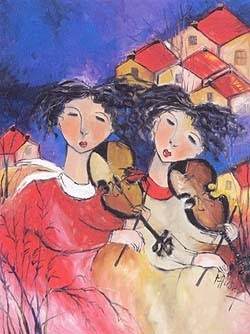"Music is an outburst of the soul."
AUTHOR: Frederick Delius
MEANING OF THE QUOTE:
"Music is not just organized sound, it is
an expression of the human condition."
CONCERTO for TWO VIOLINS
A MINOR RV 522 OPUS 3 NO. 8
from "L'estro armonico"
Josef Suk and Gunars Larsens, Violins
Rudolf Baumgartner, Conductor
Festival Strings De Lucerne
Allegro (0:08)
Larghetto e spiritoso (4:02)
Allegro (10:01)
The Concerto for Two Violins in A minor, Op.3
No. 8, RV 522, is a piece of music which is a
part of Vivaldi's first published set of concertos,
written in 1711, as a collection of twelve
concertos for for one, two, three, or four violins
called "L'estro armonico," ["harmonic inspiration"
or “musical genius”(“estro” is a word which can
mean genius; armonico means harmony)]
meaning that it is music inspired by harmony.
It was published in about 1712 by the Dutch firm
of Etienne Roger, which widely distributed
Vivaldi's music in beautifully engraved editions
giving the set a catchy title, drawing attention to
this composer who was not yet known in the
north. After this publication there was a rapid
rise of Vivaldi's popularity which fueled demand
for him to create more music and very quickly
made him famous throughout Europe. Reprinted
many times and performed all over Europe,
L’estro armonico was perhaps the most popular
and influential music publication of the first half
of the eighteenth century.
This collection was so well received even J.S.
Bach knew of them transcribing six concerti from
the twelve in l’Estro armonico for organ or
keyboard, one of which is this A-minor Concerto.
Vivaldi’s music played an important role in
influencing Bach’s musical development as a
composer as he studied and used Vivaldi's
stylistic formats not only in his concertos, but in
many other instrumental and vocal genres.
The Concerto in A minor, RV 522, (the eighth work
in the collection) is a three-movement (fast-slow
-fast) work with the presence of two solo violins
(concertino) plus an orchestral ripieno of violins,
violas, cello, and basso continuo (called concerti
grossi due to their use of this concertino-style
ensemble). This particular concerto has become
a favorite of both professional and amateur
musicians because of its virtuoso writing for the
soloists, sharp contrast between the solo
instruments and the larger orchestra, and an
endless supply of rhythmic, constantly driving
forward energy.
The opening movement, Allegro, has a powerful,
energetic but serious opening theme for the
ripieno (orchestra) followed by the two soloists
playing in varied ways: unison, sometimes in
thirds, and throughout the movement exchanging
roles, taking turns leading and accompanying
(with the second violin part often set above
the first violin).
Written in D minor, the second middle movement,
called "e spiritoso," starts with an opening unison
serving as the ostinato (repeated) bass line for
the entire movement as the two solo violins
perform tuneful solos of long melodic passages
high above it ending with a final orchestral
unison restatement.
The closing Allegro returns to the virtuoso manner
of the opening movement starting with a fast and
imitative sequence (functioning as a theme) for
the ripieno (orchestra) alternating for the rest of
the movement with soloists playing off each other
with long and inventive solos finally leading to a
strong ending cadence.
| Roy Lichtenstein: The Violin, 1976 |
LINKS



.jpg)

